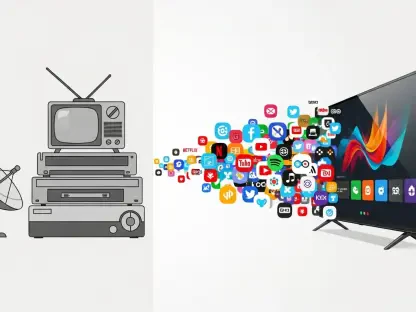In a rapidly evolving tech landscape, the clash between innovation and regulation has taken center stage, with one of the world’s leading technology giants, Apple, at the heart of the controversy over its tightly controlled ecosystem. Renowned for groundbreaking products, Apple has publicly criticized European Union regulators for what it perceives as a direct threat to its creative essence. The company argues that the EU’s push for interoperability and open competition risks eroding the very elements that have made its devices iconic. This dispute highlights a broader tension across the global tech industry, where governmental oversight often collides with corporate autonomy. As regulators aim to dismantle so-called walled gardens to foster consumer choice, the question arises: at what cost does this come to innovation? This ongoing battle, alongside other significant developments in connectivity and digital services, paints a complex picture of progress and constraint in the technology sector.
Regulatory Tensions in the Tech Sphere
The friction between Apple and EU regulators has escalated into a high-profile standoff, with the company accusing Brussels of jeopardizing user experience through stringent mandates. Apple’s senior vice president of worldwide marketing, Greg Joswiak, has voiced strong opposition to policies that demand greater compatibility between Apple’s products and those of competitors. Such requirements, he claims, not only stifle the company’s ability to innovate but also infringe on intellectual property rights while compromising privacy and security standards. This criticism reflects a deep-seated concern that the unique integration of hardware and software—often described as the brand’s magic—could be undermined by external interference. The EU, on the other hand, remains steadfast in its mission to curb monopolistic practices and ensure a level playing field, arguing that openness benefits consumers through choice and affordability. This divide underscores a fundamental debate about how much control tech giants should retain over their ecosystems in the face of regulatory pressure.
Beyond the rhetoric, the Apple-EU conflict is emblematic of a broader trend where tech companies face increasing scrutiny over their business models. Fines and legal appeals have become commonplace as regulators challenge the closed systems that define many leading brands. For Apple, the stakes are particularly high, as its ecosystem is a cornerstone of customer loyalty and brand identity. The company contends that forcing interoperability could dilute the seamless experience users expect, potentially leading to fragmented services and reduced reliability. Meanwhile, critics of Apple’s stance argue that such resistance prioritizes profit over competition, limiting innovation from smaller players who struggle to penetrate a market dominated by giants. This ongoing saga reveals a critical fault line in the tech industry, where the balance between protecting proprietary systems and promoting market fairness remains elusive. As both sides dig in, the resolution of this dispute could set a precedent for how technology regulation evolves globally over the coming years.
Connectivity Breakthroughs Across Borders
On a more progressive note, advancements in network technology are reshaping how users interact with devices, as demonstrated by Deutsche Telekom’s latest achievement in Germany. The telecom operator has become a pioneer by enabling the newest Apple Watch to connect via 5G using RedCap (reduced capability) technology on its standalone 5G network. This innovation allows users to link their wearables to their iPhones through MultiSIM functionality, sharing the same phone number and effortlessly switching to LTE when 5G coverage is unavailable. Such developments signal a growing integration of wearable tech with cutting-edge network capabilities, enhancing user convenience and connectivity. This move by Deutsche Telekom exemplifies how operators are leveraging 5G to push boundaries, offering practical solutions that align with the increasing demand for seamless, always-on digital experiences in everyday life.
Elsewhere, the focus on digital infrastructure extends to emerging markets, where Safaricom in Kenya has unveiled a significant upgrade to its M-Pesa mobile payment platform. The enhancement boosts transaction capacity from 4,500 to 6,000 per second, with the potential to scale up to 12,000, thanks to a revamped architecture distributed across multiple hosting sites. This design improves resilience and minimizes service disruptions, addressing the needs of a growing user base reliant on mobile financial services. The upgrade reflects a broader trend in regions with limited traditional banking access, where technology drives economic inclusion by enabling secure, efficient transactions. Safaricom’s initiative highlights the transformative power of digital tools in fostering financial empowerment, positioning mobile payments as a cornerstone of modern economies. As such platforms evolve, they pave the way for greater operational efficiency and accessibility, bridging gaps that once hindered economic participation in underserved communities.
Digital Transformation and Legal Safeguards
In the realm of media and broadcasting, strategic shifts are underway, as seen with Net Insight, a Swedish video transport specialist adapting to industry changes. The company has restructured its leadership by appointing Christer Bohm to its CTO group to spearhead product and technology strategy, moving him from the executive management team. This realignment aligns with a transition toward a more IP-based portfolio, mirroring a wider industry pivot to digital and internet protocol solutions. Such changes underscore the necessity for agility in a sector increasingly defined by streaming and on-demand content delivery. By prioritizing IP-focused innovation, Net Insight aims to stay ahead of the curve, ensuring its offerings meet the demands of a rapidly digitizing market where traditional broadcast models are giving way to flexible, internet-driven alternatives.
Simultaneously, the fight against digital piracy has gained momentum, with French soccer’s governing body, LFP, securing a legal victory to protect its intellectual property. An injunction against major search engines like Google and Bing compels them to delist illegal streaming sites and IPTV services broadcasting Ligue 1 and Ligue 2 matches without authorization. This action marks a significant step in combating unauthorized content distribution, highlighting the growing collaboration between content creators and tech platforms to safeguard rights in the streaming era. The move addresses a persistent challenge in the digital age, where piracy undermines revenue for sports organizations and content providers. As legal frameworks adapt to technological realities, such efforts signal a concerted push to balance innovation with accountability, ensuring that the benefits of digital access do not come at the expense of creators’ livelihoods or industry sustainability.
Reflecting on a Complex Tech Landscape
Looking back, the myriad developments in the tech and telecom sectors reveal a dynamic interplay of innovation, regulation, and legal protections that shape the industry’s trajectory. Apple’s sharp critique of EU regulators underscores a pivotal clash over the future of tech ecosystems, while Deutsche Telekom’s 5G advancements and Safaricom’s M-Pesa upgrades demonstrate tangible progress in connectivity and financial inclusion. Net Insight’s strategic pivot to IP-based solutions and LFP’s anti-piracy triumph further illustrate how diverse challenges demand tailored responses. Moving forward, stakeholders must navigate these complexities by fostering dialogue between innovators and regulators to strike a balance that preserves creativity without sacrificing fairness. Collaborative frameworks and adaptive policies could serve as the foundation for sustainable growth, ensuring that technology continues to evolve while addressing the legitimate concerns of competition and consumer rights in an ever-changing digital world.









